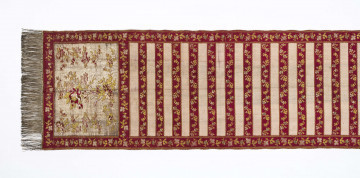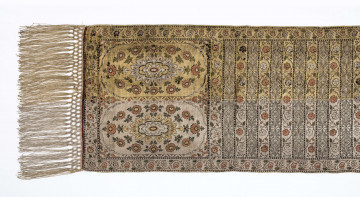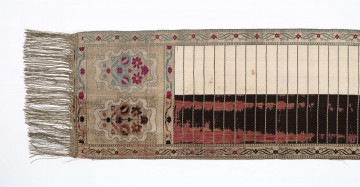
One-sided kontusz belt
1766 — 1788
National Museum in Lublin
Part of the collection: Textiles, embroideries, clothing and costume accessories
An indispensable addition to the clothing of the Polish nobleman in the 17th and 18th centuries was the kontusz belt. From the 15th century, textile belts made of ribbons and braids, and more expensive ones made of silk were popular. However, in Poland kontusz belts became popular thanks to Armenians, who first imported them from Persia and Turkey, and then initiated their production in workshops established locally, in the lands of the Republic of Poland. Thus, the clothing of the Polish nobleman, which developed in the 1730s-40s, consisted of a żupan, kontusz, trousers with legs let into shoes, a cap lined with fur, and a kontusz belt.
The belt was usually no more than three metres long and forty centimetres wide. It usually consisted of a head, a belt and a shelf. The head was called the beginning and the end of the belt. This is not without reason, as the material, which originated in the East, was worn in the form of a turban wrapped around the head with its richly decorated ends left open. Thus, it was only secondarily given the function of girdling, which was so firmly rooted and developed in the culture of the nobility. The central part of the fabric in the form of a long rectangle was still called a girdle, while the elements dividing it into transverse strips were called shelves, and it was additionally provided with tassels at both ends. The outer ornamental decoration was called a border The value of the belt increased with the use of precious metals - gold or silver thread forming the background or ornamentation; the belts tied on the nobleman's żupan were, in a sense, a jewel - an extremely decorative element, in which the use of a special technique of pressing gold or silver threads gave a rare, and thus extremely desirable mirror shine. The type of kontusz belt worn said a lot about its owner. Not only did it determine the social and material status of the nobleman (the most beautiful belts reached exorbitant prices), but sometimes also indicated his religion. The colour of the belt and its intricately arranged knot and pattern also had symbolic and informative value. A golden belt was worn in times of peace, while a crimson one was worn during military operations.
Author / creator
Dimensions
cały obiekt: height: 322 cm, width: 27,5 cm
Object type
a contoured belt
Technique
weaving
Material
silk
Creation time / dating
Creation / finding place
Owner
The National Museum in Lublin
Identification number
Location / status

1766 — 1788
National Museum in Lublin

1789 — 1793
National Museum in Lublin

1767 — 1780
National Museum in Lublin
DISCOVER this TOPIC
National Museum in Lublin
DISCOVER this PATH
Educational path